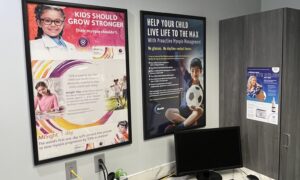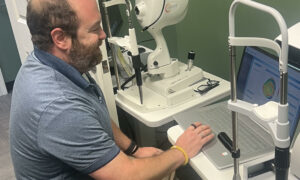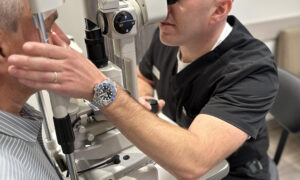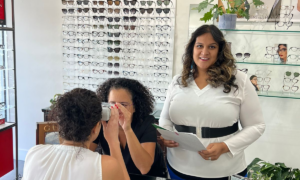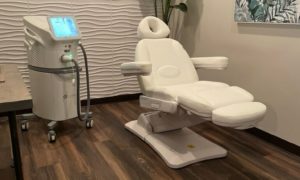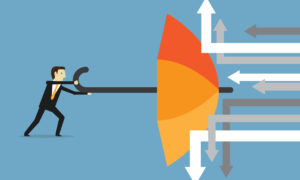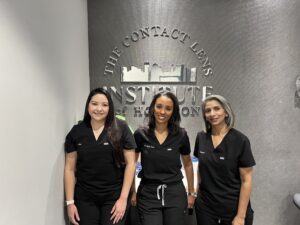
Dr. Tucker, center, with her support staff team members, Sarah and Christine. The three of them work together to streamline the process of seeing all of Dr. Tucker’s specialty patients. They also go over the schedule every morning together to strategize how to get patients seen efficiently. “They are my dream team!” says Dr. Tucker.
How to master patient flow for specialty contact lens patients.
By Ashley W. Tucker, OD, FAAO, FSLS, Diplomate, ABO
May 8, 2024
It is incredibly rewarding to have specialty contact lenses as a practice niche. However, to create a great experience for these patients, and to maintain efficiency, you have to know the best way to move them through your office.
How Much Time Do Most Specialty CL Patients Need?
I see around 250 new specialty contact lens patients per year. This breaks down to about 20 patients per month and about five per week.
I schedule new specialty lens patients for 20 minutes, which is the same for all of my other patients – both glasses and regular contact lens patients. I played with making specialty contact lens patient visits longer, but I learned that it all balances out just fine.
Since I only see patients 2.5 days per week, I already have limited clinic time, so I cannot realistically specify which days I see these patients. I also don’t reserve specific time slots for specialty contact lens patients. I just try to ensure that I am not seeing more than two per morning and two per afternoon.
On average, my specialty contact lens patients follow-up with me four times, but some need to follow-up much more because their case is more complicated. Even if it takes 10 follow-ups (which is very rare), I never had a patient complain because I assure them that I am not going to stop until we are both satisfied with the outcome – being mindful of the warranty of course! Each manufacturer offers a warranty on their lenses, which is typically 90-120 days. This varies, so be sure to have a clear understanding of the warranty so you can communicate this to your team and patient.
Patients must come in for the first dispense due to the need for application and removal training and for me to assess the fit on the first lens. I then like to see them after they have worn the new lens for two weeks. After that, if appropriate, I will direct-ship additional lenses to their home to avoid a trip to the office. I then will follow-up with them after they have each new lens for two weeks.
What Should Be Done Before They See You?
Before the patient sees me, I have my team do a topography and auto-refraction (not always successful), read the Rx on their glasses, if they have them, and check visual acuity.
How Does Your Time During First Visit Break Down in Exam Room?
I typically spend the first 10-15 minutes of the visit getting a thorough history. This includes a medical history, list of medications and ocular history. Ocular history includes their specialty contact lens-related diagnosis (keratoconus, corneal scar, dystrophy, dry eye disease), ocular surgery (RK, LASIK, PRK, corneal transplant) and previous contact lens history (whether they are a contact lens neophyte or what other designs they tried and whether they were successful).
Other Articles to Explore
This time is very important to spend with the patient. I learn so much about them and their personality. I also ask what their goals are. Are they seeking to improve overall vision or just distance vision? Do they hate glasses, or are they open to supplementing their contacts with glasses if needed?
I often have to assure the patient that I am going to offer something different than all of the other doctors they have seen because most of them have seen several other doctors and tried several other contacts that they failed in. It’s almost like a therapy session during which they get comfortable with me and can ask any questions they want.
By the end of this session with me, pretty much every patient is excited and ready to get started. I then perform an anterior segment examination with my slit lamp and make a recommendation on the type of lens they need.
For some patients, the lens I choose can be designed empirically, meaning I can use topographies and refractive data to design lenses. For those patients, the first visit is over at that point and they leave.
When Does Diagnostic Fitting Happen for Most Patients?
I do the diagnostic fitting for most patients during their first visit.
I have one of my team members come in and put a diagnostic lens on each eye that I am fitting. During this time, I typically step out and see the next patient. I can do this because I never schedule two specialty contact lens patients back-to-back. For many patients, this process can take a while because they are new to contacts, but for others, it takes moments.
For the quick ones, I will pop back in to see if I like the fit. For others, I will circle back after I am done with the next patient. I have all of my patients sit in the diagnostic lens for 15-20 minutes. After they have sat in the lenses, they undergo a series of scans to assess the fit (anterior segment OCTs imaging) and an auto-refraction over the lenses.
Sometimes I have time to see two additional patients before the patient is ready to see me again. When they are ready, I meet them back in the exam room to assess the fit and scans and to perform an over-refraction.
Then, we chat about the ordering process and my tech comes back in to remove the lenses, answer any additional questions the patient may have and get the patient checked out.
When Specialty CL Patient Bottlenecks Occur, What is the Usual Culprit?
We only have one OCT and one topographer, so it is not ideal for us to have multiple patients in need of these tests at one time, but it happens. We always have at least three other doctors seeing patients, so their patients may be in need of the same tests. It truly is unavoidable, but we try to look at the schedule ahead of time and anticipate these issues, if at all possible.
Since my specialty contact lens patient will need both an OCT and topography, we try to predetermine which order makes the most sense to do these tests to avoid a bottleneck.
For example, if we have a new Ortho-K fit at the same time, the Ortho-K patient will get the topography while my patient is getting an OCT. Or if we have a GLC patient coming in, the GLC patient will get the OCT, while my patient is getting a topography. Even with pre-planning, however, we sometimes have bottlenecks.
Patients are usually understanding. We just explain to them that the instrument they need to be tested on is in use and that they are next in line!
Make Sure You Have a Well-Trained Team to Support You
I always have a well trained staff member putting lenses on and taking them off. They run all special testing and they do all of the application and removal training. I often, but not always, have a technician with me in the exam room to scribe. This is really helpful when I am assessing the fit and need someone to take notes in real time. It’s important to have at least one trained team member who can answer calls when patients have questions.
Anticipate Additional Questions after Patients Get Home & Provide Take-Home Materials
No matter how much time you spend with patients in the office, many will have questions when they get home. To alleviate some of this, we send patients home with a thorough document that goes over cleaning, storing, application and removal and FAQs.
We also have a QR code with a link to a video on how to do A&R, clean and store their lenses.
 Ashley W. Tucker, OD, FAAO, FSLS, Diplomate, ABO, is a partner with Contact Lens Institute of Houston (CLIH) within Bellaire Family Eye Care (BFE) in Houston, Texas. To contact her: Tucker@bfeye.com
Ashley W. Tucker, OD, FAAO, FSLS, Diplomate, ABO, is a partner with Contact Lens Institute of Houston (CLIH) within Bellaire Family Eye Care (BFE) in Houston, Texas. To contact her: Tucker@bfeye.com

